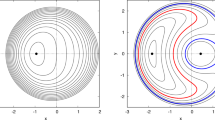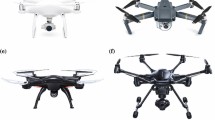Summary
The linear stability of the attitude of a tethered satellite system, consisting of an asymmetric satellite with two equal tethered masses arranged vertically, is studied. The differential equations of motion are established, the attitude stability conditions are found, and then entered into a Magnus triangle. It is concluded that a tether parameterΔ has a significant effect on the satellite's attitude stability. By increasing the value of Δ, the stable regions in the Magnus triangle grow, until they cover more than half of its area, and then decline to exactly one half.
Übersicht
Die lineare Stabilität der Orientierung, d. h. der Winkellage, eines Systems aus einem starren Hauptsatelliten mit zwei im Schwerefeld vertikal an Seilen befestigten Punktmassen wird untersucht. Die Bewegungsgleichungen werden hergeleitet, deren Stabilitätsgrenzen berechnet und ins Magnussche Formdreieck eingetragen. Es wird gezeigt, daß der Seilparameter Δ einen entscheidenden Einfluß auf das Stabilitätsverhalten hat. Je größer der Seilparameter ist, desto grïoßer werden die Stabilitätsgebiete, bis sie mehr als die Hälfte des Magnusschen Formdreiecks ausmachen, um bei weiterem Ansteigen dann auf genau die Hälfte zurückgehen.
Similar content being viewed by others
References
Ionasecu, R.; Penzo, P. A.: Innovative space tethers. Spaceflight 30 (1988) 200–208
Vallerani, E.; Bevilacqua, F.: New applications of tethered satellites: An Italian perspective. In: Bainum, P. M.; Bekey, I.; Guerriero, L.; Penzo, P. A. (eds.): Advances in the astronautical sciences, Vol. 62: Tethers in space, pp. 63–70. San Diego: Univelt 1987
Rimrott, F. P. J.: Introductory attitude dynamics. New York: Springer 1988
Arnold, D. A.: The Behavior of long tethers in space. In: Bainum, P. M.; Bekey, L; Guerriero, L.; Penzo, P. A. (eds.): Advances in the astronautical sciences, Vol. 62: Tethers in space, pp. 35–50. San Diego: Univelt 1987
Bevilacqua, F.; Viardo, S.; Loria, A.: Space station gravity gradient stabilization by tethers. In: Proc. second. international conference on tethers in space, pp. 63–88, Venezia 1987
Chetayef, N. G.: The stability of motion. London: Pergamon Press 1961
Penzo, P. A.: A survey of tether applications to planetary exploration. In: Bainum, P. M.; Bekey, I.; Guerriero, L.; Penzo, P. A. (eds.): Advances in the astronautical sciences, Vol. 62: Tethers in space, pp. 71–88. San Diego: Univelt 1987
Rimrott, F. P. J.: Introductory orbit dynamics. Braunschweig: Vieweg 1989
Author information
Authors and Affiliations
Rights and permissions
About this article
Cite this article
Rimrott, F.P.J., Pan, R. Attitude stability of a tethered satellite in locked rotation. Ing. arch 60, 419–430 (1990). https://doi.org/10.1007/BF00531253
Received:
Issue Date:
DOI: https://doi.org/10.1007/BF00531253




